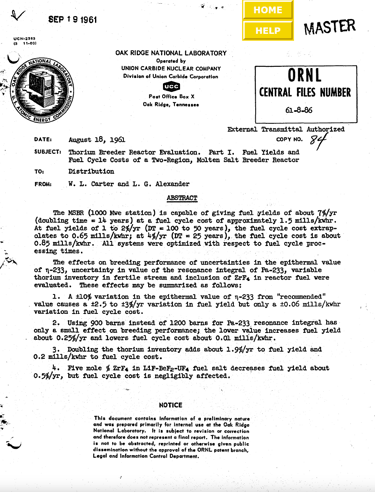MSRE’s Economic Blueprint: What Every Gen IV Reactor Company Should Study
From procurement to project delays, a forgotten 1968 ORNL cost report still teaches the nuclear industry how to build wisely
EGENERATION LIBRARY
👥 Authors
The report was prepared by:
G.F. Evensen,
C.A. McNeese, and
D.C. Manning
Affiliation: Oak Ridge National Laboratory (ORNL), under the U.S. Atomic Energy Commission
These individuals were involved in financial, procurement, and administrative aspects of the Molten Salt Reactor Experiment (MSRE), making this report a first-hand economic account of a pioneering nuclear project.
🧾 Summary
Title: Cost Experience and Schedule History of the Molten Salt Reactor Experiment (MSRE)
Date: August 1961 (finalized post-project in 1968 as a full retrospective)
This report provides a candid and detailed cost-accounting and scheduling analysis of the Molten Salt Reactor Experiment (MSRE) at Oak Ridge National Laboratory. It was written to inform future development of advanced reactors by offering a transparent look at what was spent, what went right, and where delays and adjustments occurred.
Key Takeaways:
💰 Project Costs and Financial Structure
Original estimated cost: ~$4.7 million (FY1958 dollars)
Final cost: ~$9.8 million by project completion in FY1965
Despite nearly doubling in cost, the project was still economically efficient given its scale, innovation, and lack of precedent.
Detailed breakout provided for:
Systems design and engineering
Equipment and materials
Construction and testing
Labor and administrative overhead
R&D related to salt chemistry and remote maintenance
🕒 Schedule History
Initial estimate: ~3 years
Actual project duration: ~5.5 years (including design evolution and additional experimentation with U-233 fuel)
Major delay factors:
Evolving design objectives due to MSRE’s experimental nature
Challenges in fabricating salt containment vessels and valve reliability
Expansion of scope to include full U-233 operation phase
⚖️ Lessons and Value
The value gained per dollar was considered extremely high: MSRE validated the viability of liquid-fueled reactors, high-temperature operation, and passive safety principles.
Provided critical experience in remote maintenance, salt corrosion resistance, and component lifetime—all foundational for modern MSR development.
Click on the document image to view or download the document!
💡 From Oak Ridge to the 21st Century: What Gen IV Nuclear Startups Can Learn from the MSRE Cost Experience
“The path to innovation is not paved with perfection, but with lessons you cannot afford to ignore.”
— Adapted from ORNL’s postmortem of the Molten Salt Reactor Experiment (MSRE)
In an age where nuclear innovation is reborn in the form of molten salt reactors, sodium fast reactors, and high-temperature gas-cooled designs, today’s Gen IV reactor developers would do well to pause and study a slim but powerful document from 1968: CF-61-8-86 – Cost Experience and Schedule History of the Molten Salt Reactor Experiment (MSRE).
Prepared by Oak Ridge National Laboratory (ORNL), this report is not a victory lap. It’s a sober accounting—a reflection on what it took, financially and operationally, to build one of the most innovative nuclear reactors in American history. The MSRE was not only a technical success; it was economically lean and administratively revealing.
Here are the top five lessons Gen IV nuclear developers should take to heart—before steel is cut or salt is melted.
🏗️ 1. Scope Evolution Is Inevitable—Plan for It Upfront
Then:
The MSRE was initially envisioned as a small, proof-of-concept reactor to demonstrate the feasibility of using molten fluoride salt as both fuel and coolant. The scope ballooned over time as ORNL decided to:
Extend reactor life to include operation on U-233 in addition to U-235
Upgrade remote maintenance capabilities
Perform additional salt chemistry and material studies
Lesson for Gen IV Developers:
Your prototype will change shape as the technology matures. Build scope buffers into your budget and schedule. Allow for discovery, but constrain unnecessary design sprawl. Innovation without discipline is a cost spiral.
💸 2. Track Budget in Detail—and Share It Transparently
Then:
The original MSRE estimate was $4.7 million (1958 dollars). The final cost? $9.8 million. Not great, but not catastrophic either, given it delivered an entirely new reactor class. What made the difference was transparency:
Costs were divided into clear categories: procurement, labor, testing, and R&D
Monthly and quarterly tracking allowed responsive adjustments
Lesson for Gen IV Developers:
Today’s startups are often awash in venture or government capital. But sloppy accounting kills credibility, especially with regulators and institutional investors. Embrace the granularity of your burn rate. Publish your cost structure. It’s not weakness—it’s leadership.
📆 3. Schedule Discipline Is Cultural, Not Just Managerial
Then:
The project was supposed to take three years. It took five and a half. Why? Not from laziness, but from:
Vendor issues with custom equipment
Valve malfunctions that required redesign
Underestimating the time required for salt purification and handling
Yet, the core team maintained momentum. They adapted with engineering rigor, not administrative panic.
Lesson for Gen IV Developers:
Delays will happen. The difference lies in how your team responds. Make “schedule fidelity” part of your internal culture—celebrate it, reward it, and defend it against the temptation to drift.
⚙️ 4. Simplicity Scales, Complexity Fails
Then:
The MSRE succeeded because it was kept simple on purpose:
One fluid, one containment system
No high-pressure vessels
No solid fuel assemblies
This meant faster prototyping, lower risk, and fewer fabrication bottlenecks.
Lesson for Gen IV Developers:
Many Gen IV designs today promise revolutionary leaps—but some fall into the trap of layering complexity on top of complexity. Learn from MSRE: start with what works, then iterate. Elegance in design is not minimalism—it’s cost-efficient resilience.
🔍 5. Remote Maintenance and Modularity Must Be Designed, Not Hoped For
Then:
MSRE pioneered remote maintenance techniques, including modular removal of reactor components using cranes and shielded tools. This saved personnel exposure and enabled repairs that would be impossible in a conventional PWR.
But this was deliberately planned, not bolted on later.
Lesson for Gen IV Developers:
If you plan to sell your system as "maintainable," "modular," or "mobile"—prove it in the design stage. Integrate hot cell logistics, component replacement protocols, and radiation shielding into your early models. Retrofitting modularity is a contradiction in terms.
📈 Conclusion: The Economics of Humility
The MSRE wasn’t cheap because it was perfect. It was cost-effective because it was honest: about risk, about delay, and about the learning curve.
CF-61-8-86 is not a footnote. It’s a manual for how to build emerging nuclear technology in the real world, where investors are impatient, regulators are skeptical, and engineering teams are spread across time zones.
If Gen IV developers want to succeed—not just technically, but commercially—they should treat this 1968 report like scripture.
You don’t have to reinvent the reactor.
But you do need to understand how it was built—and what it actually cost.


By William H. Thesling Ph.D.




